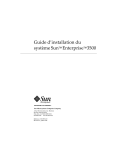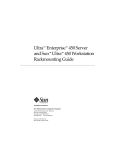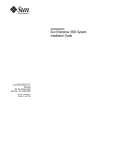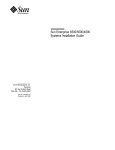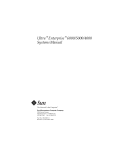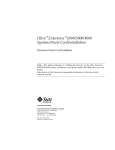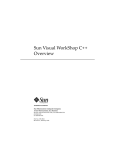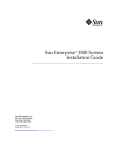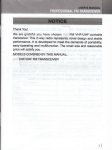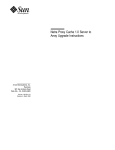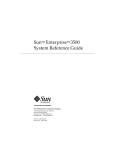Download Ultra Enterprise 3000 System Installation Guide
Transcript
Ultra™ Enterprise™ 3000 System Installation Guide The Network Is the Computer™ Sun Microsystems Computer Company 2550 Garcia Avenue Mountain View, CA 94043 USA 415 960-1300 fax 415 969-9131 Part No.: 802-6050-10 Revision A, May 1996 Copyright 1996 Sun Microsystems, Inc. 2550 Garcia Avenue, Mountain View, California 94043-1100 U.S.A. All rights reserved. This product or document is protected by copyright and distributed under licenses restricting its use, copying, distribution, and decompilation. No part of this product or document may be reproduced in any form by any means without prior written authorization of Sun and its licensors, if any. Portions of this product may be derived from the UNIX® system and from the Berkeley 4.3 BSD system, licensed from the University of California. UNIX is a registered trademark in the United States and in other countries and is exclusively licensed by X/Open Company Ltd. Third-party software, including font technology in this product, is protected by copyright and licensed from Sun’s suppliers. RESTRICTED RIGHTS LEGEND: Use, duplication, or disclosure by the government is subject to restrictions as set forth in subparagraph (c)(1)(ii) of the Rights in Technical Data and Computer Software clause at DFARS 252.227-7013 and FAR 52.227-19. Sun, Sun Microsystems, the Sun logo, Solaris, Solstice, SyMON, OpenBoot, Enterprise, SunVTS, Ultra, UltraComputing, UltraServer, and UltraSPARC are trademarks or registered trademarks of Sun Microsystems, Inc. in the United States and in other countries. All SPARC trademarks are used under license and are trademarks or registered trademarks of SPARC International, Inc. in the United States and in other countries. Products bearing SPARC trademarks are based upon an architecture developed by Sun Microsystems, Inc. The OPEN LOOK® and Sun™ Graphical User Interfaces were developed by Sun Microsystems, Inc. for its users and licensees. Sun acknowledges the pioneering efforts of Xerox Corporation in researching and developing the concept of visual or graphical user interfaces for the computer industry. Sun holds a nonexclusive license from Xerox to the Xerox Graphical User Interface, which license also covers Sun’s licensees who implement OPEN LOOK GUIs and otherwise comply with Sun’s written license agreements. X Window System is a trademark of X Consortium, Inc. THIS PUBLICATION IS PROVIDED “AS IS” WITHOUT WARRANTY OF ANY KIND, EITHER EXPRESS OR IMPLIED, INCLUDING, BUT NOT LIMITED TO, THE IMPLIED WARRANTIES OF MERCHANTABILITY, FITNESS FOR A PARTICULAR PURPOSE, OR NON-INFRINGEMENT. Copyright 1996 Sun Microsystems, Inc., 2550 Garcia Avenue, Mountain View, Californie 94043-1100 U.S.A. Tous droits réservés. Ce produit ou document est protégé par un copyright et distribué avec des licences qui en restreignent l’utilisation, la copie et la décompilation. Aucune partie de ce produit ou de sa documentation associée ne peut être reproduite sous aucune forme, par quelque moyen que ce soit, sans l’autorisation préalable et écrite de Sun et de ses bailleurs de licence, s’il y en a. Des parties de ce produit pourront être derivées du système UNIX® et du système Berkeley 4.3 BSD licencié par l’Université de Californie. UNIX est une marque enregistrée aux Etats-Unis et dans d’autres pays, et licenciée exclusivement par X/Open Company Ltd. Le logiciel détenu par des tiers, et qui comprend la technologie relative aux polices de caractères, est protégé par un copyright et licencié par des fournisseurs de Sun. Sun, Sun Microsystems, le logo Sun, Solaris, Solstice, SyMON, OpenBoot, Enterprise, SunVTS, Ultra, UltraComputing, SunVTS, UltraServer, et UltraSPARC sont des marques déposées ou enregistrées de Sun Microsystems, Inc. aux Etats-Unis et dans d’autres pays. Toutes les marques SPARC, utilisées sous licence, sont des marques déposées ou enregistrées de SPARC International, Inc. aux Etats-Unis et dans d’autres pays. Les produits portant les marques SPARC sont basés sur une architecture développée par Sun Microsystems, Inc. Les utilisateurs d’interfaces graphiques OPEN LOOK® et Sun™ ont été développés de Sun Microsystems, Inc. pour ses utilisateurs et licenciés. Sun reconnaît les efforts de pionniers de Xerox Corporation pour la recherche et le développement du concept des interfaces d’utilisation visuelle ou graphique pour l’industrie de l’informatique. Sun détient une licence non exclusive de Xerox sur l’interface d’utilisation graphique, cette licence couvrant aussi les licenciés de Sun qui mettent en place les utilisateurs d’interfaces graphiques OPEN LOOK et qui en outre se conforment aux licences écrites de Sun. Le système X Window est un produit du X Consortium, Inc. CETTE PUBLICATION EST FOURNIE "EN L’ETAT" SANS GARANTIE D’AUCUNE SORTE, NI EXPRESSE NI IMPLICITE, Y COMPRIS, ET SANS QUE CETTE LISTE NE SOIT LIMITATIVE, DES GARANTIES CONCERNANT LA VALEUR MARCHANDE, L’APTITUDE DES PRODUITS A REPONDRE A UNE UTILISATION PARTICULIERE OU LE FAIT QU’ILS NE SOIENT PAS CONTREFAISANTS DE PRODUITS DE TIERS. Please Recycle Contents 1. Preparing for Installation . . . . . . . . . . . . . . . . . . . . . . . . . . . . . . 1-1 1.1 Unpacking and Preparing the System . . . . . . . . . . . . . . . . 1-2 1.2 Shipping and Storing the System . . . . . . . . . . . . . . . . . . . . 1-3 1.3 Preparing the Electrical Circuits . . . . . . . . . . . . . . . . . . . . . 1-3 1.4 Preparing the Air Conditioning . . . . . . . . . . . . . . . . . . . . . 1-4 1.5 Preparing the Ethernet Network . . . . . . . . . . . . . . . . . . . . 1-4 1.6 Preparing the Area . . . . . . . . . . . . . . . . . . . . . . . . . . . . . . . . 1-6 1.7 Using the User Naming Area . . . . . . . . . . . . . . . . . . . . . . . 1-7 2. Cabling the System. . . . . . . . . . . . . . . . . . . . . . . . . . . . . . . . . . . . 2-1 2.1 Preparing the System for Cabling. . . . . . . . . . . . . . . . . . . . 2-1 2.2 Connecting the Power Cord . . . . . . . . . . . . . . . . . . . . . . . . 2-1 2.3 Connecting the Network Cable to the System . . . . . . . . . 2-4 2.4 Connecting the System to the Network . . . . . . . . . . . . . . . 2-5 2.5 Connecting an ASCII Terminal . . . . . . . . . . . . . . . . . . . . . . 2-7 2.6 Connecting the Fiber Cable to the I/O Board . . . . . . . . . . 2-9 iii 2.7 Connecting External SCSI Devices . . . . . . . . . . . . . . . . . . . 2-10 3. Powering the System On and Off . . . . . . . . . . . . . . . . . . . . . . . 3-1 3.1 Using JumpStart Automatic Installation . . . . . . . . . . . . . . 3-1 3.2 Powering On the System . . . . . . . . . . . . . . . . . . . . . . . . . . . 3-2 3.2.1 Reading Boot Messages . . . . . . . . . . . . . . . . . . . . . . . 3-5 3.2.2 Interpreting Status LED Patterns . . . . . . . . . . . . . . . 3-6 3.3 Powering Off the System . . . . . . . . . . . . . . . . . . . . . . . . . . . 3-8 4. Using the Software . . . . . . . . . . . . . . . . . . . . . . . . . . . . . . . . . . . . 4-1 4.1 Operating System Software. . . . . . . . . . . . . . . . . . . . . . . . . 4-1 4.2 Solstice SyMON Software . . . . . . . . . . . . . . . . . . . . . . . . . . 4-1 Index . . . . . . . . . . . . . . . . . . . . . . . . . . . . . . . . . . . . . . . . . . . iv Ultra Enterprise 3000 System Installation Guide—May 1996 Index-1 Figures Figure 1-1 Enterprise 3000 System . . . . . . . . . . . . . . . . . . . . . . . . . . . . . . . . . 1-2 Figure 1-2 Types of Network Cables Used . . . . . . . . . . . . . . . . . . . . . . . . . . 1-5 Figure 1-3 Example of 10/100BASE-T (Twisted-Pair) Ethernet . . . . . . . . 1-5 Figure 1-4 Standalone Server Access Areas — Top View . . . . . . . . . . . . . 1-7 Figure 2-1 Key Switch Standby Position . . . . . . . . . . . . . . . . . . . . . . . . . . . . 2-2 Figure 2-2 AC Power Switch, Power Receptacle, and Retainer Clip . . . . 2-3 Figure 2-3 Network Cable . . . . . . . . . . . . . . . . . . . . . . . . . . . . . . . . . . . . . . . . 2-4 Figure 2-4 10/100BASE-T Ethernet Connection . . . . . . . . . . . . . . . . . . . . . 2-4 Figure 2-5 Connecting Twisted Pair Ethernet to N-type Coaxial Cable. . 2-6 Figure 2-6 Ethernet Cabling Length — Example Using N-type Cable. . . 2-7 Figure 2-7 Clock Board . . . . . . . . . . . . . . . . . . . . . . . . . . . . . . . . . . . . . . . . . . 2-8 Figure 2-8 Fiber Cable and Fibre Card Connectors and Ports on the I/O Board . . . . . . . . . . . . . . . . . . . . . . . . . . . . . . . . . . . . . . 2-9 Figure 2-9 Onboard SCSI Connector on the I/O Board . . . . . . . . . . . . . . . 2-11 Figure 3-1 Key Switch Positions . . . . . . . . . . . . . . . . . . . . . . . . . . . . . . . . . . . 3-3 Figure 3-2 AC Power and Clock Board . . . . . . . . . . . . . . . . . . . . . . . . . . . . . 3-4 Figure 3-3 CPU Reset Switch on Clock Board . . . . . . . . . . . . . . . . . . . . . . . 3-5 v Figure 3-4 vi System Status LEDs. . . . . . . . . . . . . . . . . . . . . . . . . . . . . . . . . . . . Ultra Enterprise 3000 System Installation Guide—May 1996 3-7 Tables Table 2-1 Ethernet Cabling Limitations for N-type Coaxial Cable . . . . . 2-6 Table 2-2 Internal SCSI Lengths (Approximate) . . . . . . . . . . . . . . . . . . . . 2-10 Table 3-1 Front Panel LED System Status . . . . . . . . . . . . . . . . . . . . . . . . . . 3-7 vii viii Ultra Enterprise 3000 System Installation Guide—May 1996 Preface The Ultra™ Enterprise™ 3000 System Installation Guide provides installation instructions for the factory-configured 4-slot system. These instructions are designed for an experienced system administrator with networking knowledge. UNIX Commands This document may not include specific software commands or procedures. Instead, it may name software tasks and refer you to operating system documentation or the handbook that was shipped with your new hardware. The types of tasks that you might need to use references for includes: • • • • Shutting down the system Booting the system Configuring devices Other basic software procedures The references you can use include: • Solaris 2.x Handbook for SMCC Peripherals contains Solaris™ 2.x software commands. • On-line AnswerBook™ for the complete set of documentation supporting the Solaris 2.x software environment. • Other software documentation and Platform Notes that you received with your system. ix Typographic Conventions The following table describes the typographic changes used in this book. Typeface or Symbol Meaning Example AaBbCc123 The names of commands, files, and directories; on-screen computer output Edit your .login file. Use ls -a to list all files. machine_name% You have mail. AaBbCc123 What you type, contrasted with on-screen computer output AaBbCc123 Command-line placeholder: replace with a real name or value To delete a file, type rm filename. AaBbCc123 Book titles, new words or terms, or words to be emphasized Read Chapter 6 in the User’s Guide. These are called class options. You must be root to do this. machine_name% su Password: Shell Prompts The following table shows the default system prompt and superuser prompt for the C shell, Bourne shell, and Korn shell. x Shell Prompt C shell machine_name% C shell superuser machine_name# Bourne shell and Korn shell $ Bourne shell and Korn shell superuser # Ultra Enterprise 3000 System Installation Guide—May 1996 Related Documents The following documents contain topics that relate to the information in the Ultra Enterprise 3000 System Installation Guide. Application Title Part Number Safety/EMI Ultra Enterprise System Cabinet Regulatory Compliance Manual 802-3846 Service Ultra Enterprise 3000 System Manual 802-3845 Software SMCC SPARC Hardware Platform Guide 802-5341 Solstice SyMON User’s Guide 802-5355 Ultra Enterprise Expansion Cabinet Installation and Service Manual 802-6084 Ultra Enterprise Board Installation Guide 802-5030 Ultra Enterprise CPU Installation Guide 802-5031 Ultra Enterprise SIMM Installation Guide 802-5032 Ultra Enterprise Peripheral Power Supply Installation Guide 802-5033 Ultra Enterprise Power/Cooling Module (PCM) Installation Guide 802-6244 Ultra Enterprise Disk Board Installation Guide 802-6740 Options Preface xi Ordering Sun Documents SunDocsSM is a distribution program for Sun Microsystems™ technical documentation. Easy, convenient ordering and quick delivery is available from SunExpress™. You can find a full listing of available documentation on the World Wide Web: http://www.sun.com/sunexpress/ Country Telephone Fax United States 1-800-873-7869 1-800-944-0661 United Kingdom 0-800-89-88-88 0-800-89-88-87 France 05-90-61-57 05-90-61-58 Belgium 02-720-09-09 02-725-88-50 Luxembourg 32-2-720-09-09 32-2-725-88-50 Germany 01-30-81-61-91 01-30-81-61-92 The Netherlands 06-022-34-45 06-022-34-46 Sweden 020-79-57-26 020-79-57-27 Switzerland 155-19-26 155-19-27 Japan 0120-33-9096 0120-33-9097 Sun Welcomes Your Comments Please use the Reader Comment Card that accompanies this document. We are interested in improving our documentation and welcome your comments and suggestions. If a card is not available, you can email or fax your comments to us. Please include the part number of your document in the subject line of your email or fax message. • • xii Email: [email protected] Fax: SMCC Document Feedback 1-415-786-6443 Ultra Enterprise 3000 System Installation Guide—May 1996 Notes, Cautions, and Warnings Warning – This equipment contains lethal voltage. Accidental contact with centerplane, card cage, and drive areas can result in serious injury or death. ! Caution – Improper handling by unqualified personnel can cause serious damage to this equipment. Unqualified personnel who tamper with this equipment may be held liable for any resultant damage to the equipment. Individuals who remove any outer panels or open covers to access this equipment must observe all safety precautions and ensure compliance with skill level requirements, certification, and all applicable local and national laws. Procedures contained in this document must be performed by qualified service-trained maintenance providers. Note – Before you begin, carefully read each of the procedures in this manual. If you have not performed similar operations on comparable equipment, do not attempt to perform these procedures. Preface xiii xiv Ultra Enterprise 3000 System Installation Guide—May 1996 Preparing for Installation 1 This chapter describes how to prepare your site for the Ultra Enterprise 3000 server system. The tasks for installing the system are: 1. Unpacking the server — Chapter 1 2. Preparing the site — Chapter 1 3. Preparing the server — Chapter 1 4. Cabling — Chapter 2 5. Powering on — Chapter 3 6. Using the software — Chapter 4 Note – For information about physical specifications, electrical specifications, and environmental requirements, refer to Appendix A, “Specifications,” in the Ultra Enterprise 3000 System Manual. 1-1 1 Figure 1-1 Enterprise 3000 System 1.1 Unpacking and Preparing the System Note – Inspect all shipping cartons for evidence of physical damage. If a shipping carton is damaged, request that the carrier's agent be present when the carton is opened. Keep all contents and packing material for the agent's inspection. If the system is already unpacked, go to Section 1.3, “Preparing the Electrical Circuits.” ! 1-2 Warning – The system can weigh up to 160 lbs (73 kg). To prevent personal injury, two people are needed to lift the system safely. Ultra Enterprise 3000 System Installation Guide—May 1996 1 Tools • • #2 Phillips screwdriver Front door key (packed in a bag in the accessory box) Follow graphic instructions on the shipping container to remove the system from the container. Remove the front door key (also the keyswitch key) and power cord from the shipping container. These are needed to power on the system. Note – Any unpacking instructions printed on the outside of the shipping carton take precedence over information in this section. 1.2 Shipping and Storing the System Save the original shipping containers and packing materials in case you need to store or ship your system. If you cannot store the shipping materials, recycle or dispose of the materials properly. Consult your local recycling authority for information. 1.3 Preparing the Electrical Circuits In planning where to place your equipment, remember that each of the following items require access (by way of a separate power cord) to a power outlet: • • • Enterprise 3000 system External peripherals Monitor used for diagnostics The Enterprise 3000 system uses nominal input voltages of 100-120 VAC or 200-220 VAC. Sun products are designed to work with single-phase power systems having a grounded neutral conductor. To reduce the risk of electrical shock, do not plug Sun products into another type of power source. Contact your facilities manager or a qualified electrician if you are unsure what type of power is supplied to your building. Preparing for Installation 1-3 1 1.4 Preparing the Air Conditioning For the most reliable system operation: • • The room should have sufficient air conditioning capacity to support the cooling needs of the entire system. The air conditioning system should have controls that prevent excessive temperature changes. Refer to Appendix A, “Specifications,” in the Ultra Enterprise 3000 System Manual for environmental information. 1.5 Preparing the Ethernet Network The Enterprise 3000 system follows the IEEE standard for 10/100BASE-T Ethernet (twisted-pair) or MII (Media Independent Interface). Twisted-pair cables used with Sun Microsystems products have RJ-45 connectors that resemble the smaller RJ-11 connectors used for modular telephone cables. For twisted-pair cable length, see Chapter 2, Table 2-1. A MII to AUI converter cable, available from Sun, enables the 10/100 Mbps Ethernet interface to run over 10 Mbps coaxial Ethernet networks. Other MII Ethernet connectivity products are available from third parties. Figure 1-2 and Figure 1-3 illustrate types of network cables and possible implementations of 10/100BASE-T Ethernet. Set up the network using Sun or third party components. To obtain the best results, read any applicable manufacturer instructions. Be aware that Sun Microsystems cannot guarantee the performance of any components that are not purchased from Sun. 1-4 Ultra Enterprise 3000 System Installation Guide—May 1996 1 Vampire tap or N-type connectors Ethernet cable Server Transceiver Transceiver drop cable (coaxial or optical fiber) Hardware interface 10/100BASE-T twisted-pair cable Figure 1-2 Types of Network Cables Used Coaxial cable or optical fiber Network cable Tap Concentrator hub Tap Concentrator hub Workstation Server Twisted-pair cable Figure 1-3 Example of 10/100BASE-T (Twisted-Pair) Ethernet Note – Multiplexer boxes require a transceiver when used with the Ethernet applications described in this manual. Although these transceivers are compatible with Sun equipment, Sun Microsystems does not guarantee the performance of any component that was not purchased from Sun. Preparing for Installation 1-5 1 Many transceivers are compatible with both level-1 and level-2 Ethernet. To operate these transceivers with Sun equipment, set the device for level-2 operation following the manufacturer’s instructions. Sun equipment conforms to the Ethernet 10/100BASE-T standard, which states that the 10/100BASE-T Link Integrity Test function should always be enabled on both the host and the hub. If you have problems verifying connection between Sun equipment and your hub, verify that your hub also has the link test function enabled. Refer to Section 8.6.1, “Failure of Network Communications,” in the Ultra Enterprise 3000 System Manual (p/n 802-6051), and refer to the manual provided with your hub. 1.6 Preparing the Area Use the following guidelines to prepare a location for your server. ! • The server unit requires approximately 1.5 feet (47 cm) of space in the front and back for access by service personnel. See Figure 1-4. • A minimum space of 6 inches (16 cm) is required on both sides of the server to afford adequate air flow. Warning – To avoid exhaust air recirculation, do not put systems or peripherals next to each other, side by side. • 1-6 Keep power and interface cables clear of foot traffic. Route cables inside walls, under the floor, through the ceiling, or in protective channels. Route interface cables away from motors and other sources of magnetic or radio frequency interference. Ultra Enterprise 3000 System Installation Guide—May 1996 1 1.5 feet access at rear 6 inches on each side Standalone system 1.5 feet access at front Figure 1-4 Standalone Server Access Areas — Top View 1.7 Using the User Naming Area To display the name of the server, IP address, owner, or other important information on the front of the machine: 1. Remove the front bezel. Refer to Chapter 12, “Preparing for Service,” in the Ultra Enterprise 3000 System Manual (Section 12.3.1, “Front Bezel”). 2. Snap out the narrow transparent window. From the rear side of the bezel, gently squeeze the top and bottom edges together as you simultaneously push the transparent window out through the front of the bezel. 3. Choose the information that will appear on the label. Common items include the name of the server, IP address, name and contact information for the system administrator, and the group of users that the machine services. 4. Use the colored paper provided with the system to make a label. The available area for the paper label is 12 mm x 150 mm (0.5 in. x 5.9 in.). Print or write the desired information in an area this size and cut the label to fit the transparent window. 5. Place the paper label inside the window, and snap the window back in place from the front side of the bezel. Preparing for Installation 1-7 1 1-8 Ultra Enterprise 3000 System Installation Guide—May 1996 Cabling the System 2 This chapter contains procedures for connecting the power cord to the AC power supply and instructions for cabling the system. 2.1 Preparing the System for Cabling Make sure the server is in an area that allows access to both the front and rear of the chassis. This site should conform to site preparation guidelines and specifications covered in Chapter 1. 2.2 Connecting the Power Cord 1. Use the handle on the front of the Enterprise 3000 system to pull the front door open. 2. Locate the system key switch in the upper right corner, insert the key provided with your system, and turn the key switch to (the Standby position). See Figure 2-1. 2-1 2 Standby Figure 2-1 Key Switch Standby Position 3. Turn the AC power switch to Off. This switch is at the rear of the system, on the peripheral power supply/AC (PPS/AC) that is installed in the far left corner. See Figure 2-2. 4. Connect the female end of the power cord into the AC connector. This connector is at the rear of the system, on the PPS/AC, just below the AC power switch. See Figure 2-2. 5. Route the power cord through the power cord retainer clip. A plastic clip is attached to the back support bracket. See Figure 2-2. a. Use a Phillips screwdriver to open the plastic retainer clip. Remove the screw. b. Place the power cord inside the open clip. c. Replace the screw to reattach the retainer clip to the support bracket. 2-2 Ultra Enterprise 3000 System Installation Guide—May 1996 2 6. Connect the male end of the power cord into a grounded outlet. The outlet must be a 100-120 or 220-240 VAC 15A circuit. AC power switch AC connector Support bracket Retainer clip Figure 2-2 ! AC Power Switch, Power Receptacle, and Retainer Clip Caution – Do NOT turn on power to the unit yet. Doing so can cause system damage to occur. 7. Continue with Section 2.3 and Section 2.4 to connect the system to the network. See Sections 2.5 through 2.7 for further cabling instructions. Cabling the System 2-3 2 2.3 Connecting the Network Cable to the System The locations specified in the following instructions assume the use of twistedpair 10BASE-T or 100BASE-T Ethernet. 1. Locate the network cable. Figure 2-3 shows the twisted-pair Ethernet network cable. Figure 2-3 Network Cable 2. Connect one end of the network cable into the RJ-45 twisted-pair network port. For 10/100BASE-T Ethernet, the default interface port is the onboard connector on the I/O board in slot 1. See Figure 2-4. Ethernet port Figure 2-4 2-4 10/100BASE-T Ethernet Connection Ultra Enterprise 3000 System Installation Guide—May 1996 2 2.4 Connecting the System to the Network 1. Connect the network cable to a twisted-pair-to-transceiver interface box. 2. Connect the interface box with an appropriate cable to a network transceiver. Figure 2-5 shows a typical arrangement for connecting the system to an Ethernet network. 3. For Ethernet cables, determine if the cable has N-type screw-on connectors at the ends. • If the Ethernet cable lacks N-type connectors at the ends, use a “vampire” tap to connect the cable to the transceiver. See Figure 2-5. To connect the cable to the transceiver, use instructions provided with the vampire tap. • If the Ethernet cable has N-type connectors, connect the Ethernet cable to the transceiver: a. Screw the Ethernet coaxial cable into one of the round screw-on type connectors on the transceiver. Use either one of the transceiver connectors. b. Screw the other Ethernet coaxial cable into the other round screw-on type connector on the transceiver. 4. Determine if a terminator should be installed. Table 2-1 lists the cabling limitations for Ethernet. 5. If termination is required, install a 50-ohm terminator in the unused transceiver N connector or the end of the coaxial cable. Use a female double N-type connector. Figure 2-5 shows the elements used in the installation process. Cabling the System 2-5 2 Vampire tap or N-type connectors Ethernet cable Transceiver Transceiver drop cable (coaxial or optical fiber) Server Hardware interface 10/100BASE-T twisted-pair cable Figure 2-5 Connecting Twisted Pair Ethernet to N-type Coaxial Cable Table 2-1 lists the cabling limitations for Ethernet. Table 2-1 Ethernet Cabling Limitations for N-type Coaxial Cable Cable Segment Allowed contiguous length of cable segments Distance between transceivers (multiples-of) Length in Meters 23.4 70.2 117.0 500.01 2.52 Minimum length of Ethernet coaxial cable segments 23.4 Maximum length of transceiver “drop” cable 50.0 Minimum length of twisted pair cable no minimum Maximum length of twisted pair cable 110 1. Finite lengths (as constrained by transmission line phenomena). Minimum length = 23.4M; maximum = 500M. If cable falls shorter than one of these values, add cable to achieve next-highest value. 2. Transceivers are placed at intervals of 2.5 meters, or multiples of 2.5 meters along the Ethernet cable. Example: transceivers are connected 2.5 meters apart, not 2.0 meters. Example: transceivers are connected 15 meters apart (6 multiples of 2.5 meters), not 14.0 meters. 2-6 Ultra Enterprise 3000 System Installation Guide—May 1996 2 Figure 2-6 shows an example of a typical network setup. The Enterprise 3000 system can be any server shown in this figure. Transceiver 5 Meters Transceiver 15 Meters Transceiver 3.4 Meter Extension Transceiver drop cable Twisted pair cable Server or workstation Terminator Server or workstation Server or workstation Note: 5 Meters + 15 Meters + 3.4 Meter Extension = 23.4 Meters minimum length allowed. Figure 2-6 Ethernet Cabling Length — Example Using N-type Cable Note – Sun equipment conforms to the Ethernet 10/100BASE-T standard, which states that the 10/100BASE-T Link Integrity Test function should always be enabled on both the host and the hub. If you have problems verifying connection between Sun equipment and your hub, verify that your hub also has the link test function enabled. Refer to Section 8.6.1, “Failure of Network Communications,” in the Ultra Enterprise 3000 System Manual (p/n 802-6051), and refer to the manual provided with your hub for more information about the Link Integrity Test function. 6. If all cables are connected, power on the system. 2.5 Connecting an ASCII Terminal An ASCII terminal (or workstation) must be attached to the server to display diagnostic messages produced by the firmware (power-on self test /POST or OpenBoot™ PROM/OBP) program. A terminal is not required for normal server operations, so it may be necessary to find a terminal to connect to the server. 1. Connect the terminal cable into serial port A on the clock board. See Figure 2-7. Cabling the System 2-7 2 Serial port A Figure 2-7 Clock Board 2. Connect the terminal power cord into an AC wall outlet. 3. Configure the ASCII terminal as follows: • 9600 bps • 1 stop bit • 8 data bits • Parity off • Full duplex Refer to the instruction manual shipped with the terminal for specific configuration instructions. Note – The setup parameters listed in Step 3 may differ from the setup at the customer site. These parameters can be changed in the NVRAM. Refer to the set-defaults and printenv commands in the OpenBoot Command Reference manual, p/n 801-7076. 2-8 Ultra Enterprise 3000 System Installation Guide—May 1996 2 2.6 Connecting the Fiber Cable to the I/O Board 1. Remove the two plastic caps that cover the cable connector on the FC/OM module. 2. Remove the plastic cap covering the ends of the fiber cable. 3. Connect one end of the fiber cable into the FC/OM module installed on the I/O board. Align the notch in the cable connector with the key notch in the module connector. See Figure 2-8. 4. Connect the other end of the fiber cable into the FC/OM connector on the SPARCstorage Array (or other storage device with fiber optics interface) rear panel. Align the notch in the cable connector with the notch in the connector on the storage device rear panel. Notch on fiber cable Fibre card connector er Fib 1 Key notch in module connector er Fib 0 A B Connect cable through Port A (Fiber 0) or Port B (Fiber 1) Figure 2-8 Fiber Cable and Fibre Card Connectors and Ports on the I/O Board Cabling the System 2-9 2 2.7 Connecting External SCSI Devices External SCSI-2 devices connect to your system through the built-in singleended Fast/Wide SCSI-2 port on I/O boards (except for the board in slot 1), or through FSBE/S, DSBE/S, SWIS/S, or DWIS/S SBus cards installed on I/O boards. Note – The onboard SCSI-2 bus on the I/O board in slot 1 controls internal SCSI tray devices. Therefore, the external SCSI connector on the I/O board in slot 1 must always have a terminator installed. Note – The maximum combined length for a string of SCSI cables is six meters for non-differential cables. For differential SCSI cables, the maximum is 25 meters. When calculating the total length of a SCSI string, include external cables, internal cables, and printed traces. Table 2-2 lists internal measurements for the Enterprise servers. Table 2-2 Internal SCSI Lengths (Approximate) Location Internal Length SBus I/O board 0.43 meter Graphics I/O board 0.43 meter For information on device addressing, priorities, and slot assignments, refer to Appendix D, “Rules for System Configuration” in the Ultra Enterprise 3000 System Manual, p/n 802-6051. ! Caution – Risk of equipment damage. Do not assign the same SCSI address to two devices sharing the same SCSI bus or SBus card. To connect an external SCSI device to your system: 1. Connect a SCSI cable to the appropriate SCSI-2 host on the I/O board. • For the I/O board in slot 1, this is an SBus card installed in an appropriate SBus slot. 2-10 Ultra Enterprise 3000 System Installation Guide—May 1996 2 • For I/O boards in slots 2 through 4, use the onboard SCSI-2 port or an SBus card installed in an appropriate SBus slot. Figure 2-9 shows the location of the onboard SCSI connector on the I/O board. Fast/wide onboard SCSI-2, 68-pin connector Figure 2-9 Onboard SCSI Connector on the I/O Board 2. Connect the other end of the SCSI cable to the external SCSI-2 device. 3. Power on the system and test the server. Cabling the System 2-11 2 2-12 Ultra Enterprise 3000 System Installation Guide—May 1996 Powering the System On and Off 3 This chapter contains information about powering the system on and off, reading boot messages, and interpreting system status by viewing the LEDs. 3.1 Using JumpStart Automatic Installation The Enterprise 3000 system can use the JumpStart™ automatic installation feature that is described in installation documents for Solaris software. The software that enables this feature is present on a hard disk in your system if the system was built at the factory with internal disk boards or disk trays. JumpStart will run only when the system is powered on for the first time. ! Caution – JumpStart may incorrectly install the system as a standalone workstation. You should prevent JumpStart automatic installation from proceeding if the appropriate server-specific configuration information is not in place. Information about the JumpStart feature is on a card titled “JumpStart Installation Instructions” that is provided with the system documentation. To prevent JumpStart installation from occurring unintentionally: • • Do not connect the system to a network when you power it on initially. Do not place a Solaris release CD-ROM in a drive when you first power on the machine. 3-1 3 Note – If JumpStart automatic installation begins unintentionally, interrupt it by pressing “L1-A” (Stop-A) or “Break” (on ttya). Perform a manual installation when you are ready. If JumpStart completes the installation incorrectly, you may need to reinstall Solaris 2.x manually. 3.2 Powering On the System Note – It is advisable to connect an ASCII terminal to the system during installation. See Section 2.5, “Connecting an ASCII Terminal,” for terminal settings and connections. Observe the yellow (middle) LED on the front panel. It should go off when boot completes. If it remains lit, observe the terminal screen for boot messages produced by the firmware diagnostic program during power on. To power on the Enterprise 3000 system: 1. Begin with a safety inspection of the system. a. Use the handle on the front of the system to pull the front door open. b. Turn the system key switch to See Figure 3-1. (the Standby position). c. Turn the AC power sequencer power switch to Off. The AC power sequencer is at the rear of the enclosure. See Figure 3-2. d. Verify that the AC power cord is plugged into a wall socket. Caution – Do not disconnect the power cord from the wall socket when working on the server. This connection provides a ground path that prevents damage from uncontrolled electrostatic discharge. 2. Turn on power to any expansion cabinets. Read the documentation supplied with each type of expansion cabinet for specific instructions. 3. Turn on the terminal (if applicable). 3-2 Ultra Enterprise 3000 System Installation Guide—May 1996 3 4. Turn the AC power sequencer power switch to On. See Figure 3-2. 5. Turn the key switch to the On position. See Figure 3-1. You should see and hear several things happen: Locked Standby Diagnostics On Legend: Locked = Normal power ON in secure mode Diagnostics = Normal power ON with full diagnostics On = Normal power ON Standby = OFF; no DC power Figure 3-1 Key Switch Positions • The fans in the power supplies begin turning. • The top front panel LED (green) turns on immediately denoting the power supply is delivering DC power. • The middle front panel LED (yellow) flashes while POST runs for approximately 60 seconds. After 60 seconds, this LED turns off if the tests pass. If the LED remains lit after 60 seconds, a test has failed. • The bottom front panel LED (green) flashes to show that boot is successful and the operating system is running. If this LED fails to turn on and the middle LED is on, a severe hardware fault exists. Powering the System On and Off 3-3 3 ! Warning – Never move the system when the power is on. Failure to heed this warning may result in catastrophic disk drive failure. Always power the system off before moving it. Clock board AC power switch AC connector Figure 3-2 AC Power and Clock Board 6. Watch the terminal screen for error messages from the firmware diagnostic program. POST (power-on-self test) tests subassemblies and some interface paths between subassemblies. At the conclusion of testing, firmware automatically attempts to reconfigure the system, omitting any parts of the system that have failed diagnostics. If there are no faults, or if firmware completes a successful reconfiguration in response to detected faults, the system boots. 3-4 Ultra Enterprise 3000 System Installation Guide—May 1996 3 Note – If faulty parts are detected and configured out of the working system, you and the system manager must decide whether to operate the system until replacement parts arrive, or to halt operation. Also, if a faulty component cannot be replaced in the field, the entire subassembly (like the system board) must be replaced. 7. To restart firmware, or if the system hangs, press the CPU reset switch on the clock board. See Figure 3-3. CPU reset switch Figure 3-3 CPU Reset Switch on Clock Board 3.2.1 Reading Boot Messages Use the boot software messages to verify that all options are installed and recognized by the system. After firmware completes the system self-test, a message similar to the following will appear on your screen. The message lists hardware detected in the system. Powering the System On and Off 3-5 3 Note – This screen display is an example only. The actual message displayed on the screen will depend on the software running on your system. 4-slot Ultra Enterprise 3000, Keyboard Present OpenBoot -.- FCS, --- MB memory installed, Serial #---. Ethernet address -:-:--:-:--:--, Host ID: ------. If firmware indicates a hardware problem at this time, refer to the Ultra Enterprise3000 System Manual, Part 3, “Troubleshooting,” for further instructions. Boot the system using the procedure that is appropriate for your operating system. See the Preface, “UNIX Commands” for a reference to documentation that describes this procedure. 3.2.2 Interpreting Status LED Patterns If there is no terminal on the system, basic system status information is available on the front panel LEDs, as shown in Figure 3-4. 3-6 Ultra Enterprise 3000 System Installation Guide—May 1996 3 DC power (green) Fault (yellow) System running (green) Figure 3-4 System Status LEDs After boot, check the status of the system by inspecting system status LEDs on the front panel. See Figure 3-4 and Table 3-1, which summarizes LED status indications. Table 3-1 Front Panel LED System Status LED Position Condition Left LED (green) On — the power supply is delivering DC power Middle LED (yellow) On flashing — (first 60 seconds of AC power) self tests are running Off — (after self tests end) no hardware failures detected On — (after self tests end) hardware failure was detected Right LED (green) Off — (first 60 seconds of AC power) self tests are running On flashing — (after self tests end) system is running Off — (after self tests end) system cannot run; repair is needed Ideally, when self-test completes, both top and bottom LEDs are on. Less ideal is if all LEDs are on (system needs service, but is able to run). The worst condition is if the top and middle LEDs are on (system cannot boot), or if no LED is on. Powering the System On and Off 3-7 3 3.3 Powering Off the System Before turning off the system power, you must halt the operating system. See the Preface, “UNIX Commands,” to find references if you need help with the commands for this task or other system administration procedures. Note – Failure to halt the operating system properly can cause the loss of disk drive data. Note – Do not disconnect the terminal while the system is running. Caution – To avoid damaging internal circuits, do not disconnect or connect any cable while power is applied to the system. To shut down the system: 1. Notify users that the system is going down. 2. Back up the system files and data to tape, if necessary. 3. Halt the system using the appropriate commands. Refer to the Solaris Handbook for SMCC Peripherals that corresponds to your operating system. 4. Wait for the system-halted message and the boot monitor prompt. 5. Pull on the handle to open the system front door. 6. Locate the system keyswitch in the upper right corner, and turn the key switch to the Standby position (fully counterclockwise). See Figure 3-1. 7. Turn off the system power in this order: a. External drives and expansion cabinets (if any) b. System AC power switch (see Figure 3-2) c. Terminal For more system administration information on methods for shut-down and backup, see the Preface, “UNIX Commands” for references to documentation that describes these procedures. 3-8 Ultra Enterprise 3000 System Installation Guide—May 1996 Using the Software 4 This chapter contains information about software for your Enterprise 3000 system. 4.1 Operating System Software Refer to the operating system documentation that came with your system. 4.2 Solstice SyMON Software Solstice™ SyMON™ features a graphical user interface (GUI) display that shows various graphs reflecting system status. Solstice SyMON, intended to complement network-wide and enterprise-wide system management tools, is accessible through an SNMP interface from network tools such as Solstice SunNet Manager™. Refer to the online Solstice SyMON User’s Guide, p/n 802-5355, for starting and operating instructions. 4-1 4 4-2 Ultra Enterprise 3000 System Installation Guide—May 1996 Index A AC power cord, connecting, 2-2 switch, 2-3, 3-2 air conditioning needs, 1-4 ASCII terminal cabling and setup, 2-7 removal, 3-8 automatic installation, JumpStart, 3-1 B boot messages, 3-5 C cabling ASCII terminal, 2-7 Ethernet, length, 2-7 fiber, 2-9 network, 2-4 power, 2-1 preparing for, 2-1 SCSI, 2-10 twisted-pair, 1-4 cautions notes, warnings, xiii SCSI bus, SBus, 2-10 clearance, system, 1-6 connecting power cord, 2-2 cord, power, 1-3 D duplicate addresses, caution, 2-10 E error messages POST, 3-2 terminal, 3-2 Ethernet cable length, 2-7 limitations, 2-6 preparing for, 1-4 F fiber cable, 2-9 H halting the system, 3-8 Index-1 I installation, preparing for, 1-1 J JumpStart installation program, 3-1 K keys, location, 1-3 L LEDs status, 3-7 lifting the server, 1-2 limitations, cable, Ethernet, 2-6 link test function, 1-6, 2-7 M messages boot, 3-5 error, 3-2 MII connector, 1-4 N naming, server, IP address, etc., 1-7 network cabling, 2-4 to 2-5 site preparation, 1-4 transceiver, 1-6 notes, cautions, warnings, xiii P POST error messages, 3-2 program, 2-7 reconfiguration of system, 3-4 power cabling, 2-1 cord, location, 1-3 off the system, 3-8 Index-2 on the system, 3-2 power-on self-test See POST precaution, automatic installation JumpStart, 3-1 preparing electrical circuits, 1-3 for cabling, 2-1 for installation, 1-1 R reconfiguration, system, POST, 3-4 remove ASCII terminal, 3-8 reset switch usage of, 3-5 S SBus caution, 2-10 SCSI bus, caution, 2-10 cabling, 2-10 shipping and storing, 1-3 site preparation air conditioning, 1-4 area, 1-6 network, 1-4 software, using, 4-1 Solstice SyMON, 4-1 status LEDs, 3-7 switch AC, 2-3, 3-2 reset, 3-5 system clearance, 1-6 T test, link test, 2-7 transceiver, network, 1-6 TTY terminal, See ASCII terminal twisted-pair cable, 1-4 Ultra Enterprise 3000 System Installation Guide—May 1996 U unpacking, 1-2 W warnings, notes, cautions, xiii Index-3 Index-4 Ultra Enterprise 3000 System Installation Guide—May 1996

















































